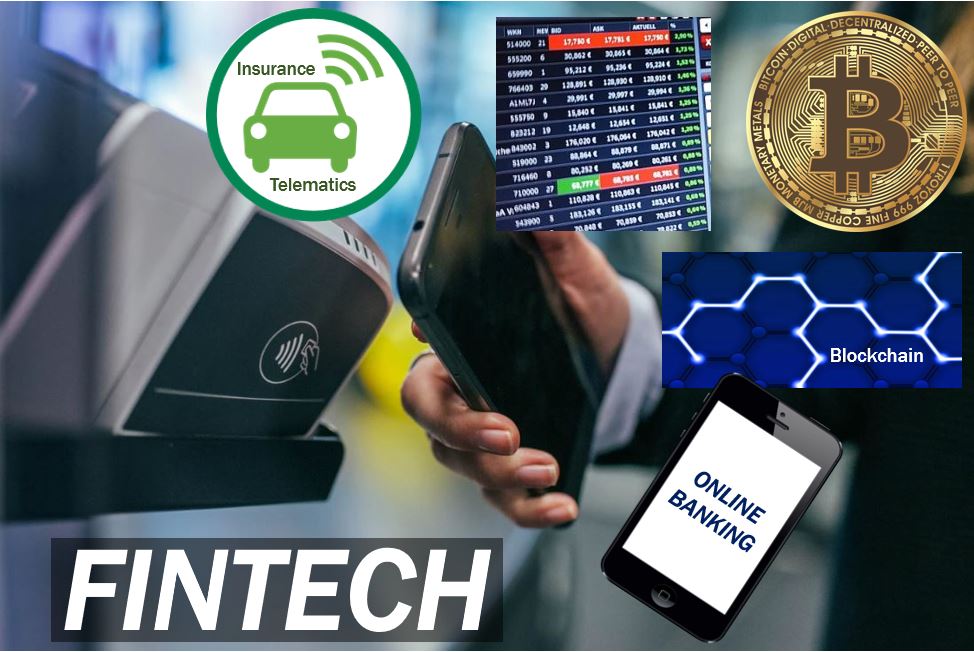What is Fintech? Definition and examples
FinTech is short for Financial Technology. It refers to the ever evolving intersection of technology and financial services. Computer software and other technology that banks, other financial institutions, and financial services companies use are examples of FinTech. It is a rapidly growing area for angel investors and venture capitalists.
An angel investor or business angel is an individual who invests his or her own money in a startup. Venture capitalists typically work for firms and may use other people’s money. We refer to the money they use in both cases as venture capital.
 FinTech helps businesses, entrepreneurs, and consumers manage their processes and financial operations more effectively and efficiently.
FinTech helps businesses, entrepreneurs, and consumers manage their processes and financial operations more effectively and efficiently.
Definitions vary
Some dictionaries and organizations say that FinTech refers to tech companies that service the banking and finance sector. Others, on the other hand, define it as simply new financial technology.
Capital.com has the following definition of the term:
“FinTech is the shortened version of the phrase Financial Technology, which is now used to describe businesses that offer financial services using software and modern technology.”
“Some FinTech developments have improved traditional services, for example mobile banking apps, while other have revolutionized services such as pay per mile car insurance or created new products, such as Bitcoin.”
FinTech is pioneering inclusive financial services, extending banking and investment opportunities to underserved populations through mobile technology and microfinance platforms.
Competing with traditional methods
Initially, financial technology competed with traditional banking and finance methods. However, over the past few decades, traditional methods have gradually fallen by the wayside. Automation and the Internet have changed how banks, other financial institutions, and customers conduct business. Even artificial intelligence has made its way into finance in a big way.
Artificial intelligence includes software programs that make smart devices, i.e., computers and robots, think like humans. They also make them behave like humans.
One of the most evident results of all this innovation has been the massive reduction in the number of bricks-and-mortar bank branches across the world.
Three or four decades ago, the most common way to pay invoices was by check (British: cheque). People and businesses currently conduct most banking transactions online. FinTech has automated banking services, risk management, trading, and insurance.
FinTech examples
-
Opening a bank account and digital wallets
Today, it is possible to open a bank account online without ever having to enter a branch building. You can do it all with your smartphone, and then use it to carry out all your financial transactions. It is even possible to apply for a loan online.
Some people have turned their mobile phone into a digital wallet, .i.e., a system that stores the user’s payment information securely. It stores all cards digitally for payments.
Companies in this modern age are even using virtual company cards, which can be a safe and secure alternative to company credit cards.
According to Soldo.com:
“A virtual card consists of a randomly generated16-digit card number which is linked to an existing credit account. It is a prepaid card which can be used for all the online purchases for which you would use a conventional credit card, but it cannot be traced back to the original account by hackers.”
-
Car insurance
Insurance companies today sell telematics-based insurance. A black box is fitted into the owner’s car and monitors his or her driving. How much their premiums cost depends on how well or badly they drive. Safe drivers pay less than their relatively dangerous counterparts.
It won’t be long before we will be able to have very short-term pay-as-you-go car insurance.
-
Investing over the Internet
According to The Central Bank of Ireland:
“Advances in technology means consumers can also invest over the internet on an “execution only” basis without any face-to-face interaction. In time, you may be able to get automated financial advice or ‘robo advice’ with little or no human interaction.”
Other FinTech examples include:
- Cryptocurrencies.
- Blockchain.
- Crowdfunding platforms.
- Budgeting apps.
- Cognitive AI (artificial intelligence).
- White label banking.
- Financial eLearning.
FinTech – vocabulary and concepts
There are many compound nouns that contain the term “Fintech,” in Business/Technical English. A compound noun is a term that consists of two or more words. Let’s have a look at some of the, their meanings, and how we can use them in a sentence:
-
FinTech Ecosystem
An interconnected community of FinTech entities and stakeholders collaborating for innovation in finance.
Example: “The startup thrived by engaging actively with the FinTech ecosystem.”
-
FinTech Startups
New businesses in the financial technology sector that typically aim to innovate and disrupt traditional financial markets.
Example: “Investors are showing great interest in a number of FinTech startups.”
-
FinTech Regulation
The body of laws and guidelines governing the operation and implementation of financial technology services and companies.
Example: “FinTech regulation ensures consumer protection while fostering innovation.”
-
FinTech Innovation
The act of creating novel and effective financial technologies or using existing technologies in new ways to solve financial problems.
Example: “Blockchain is at the forefront of FinTech innovation.”
-
FinTech Investment
The allocation of capital to financial technology ventures with the expectation of future financial returns.
Example: “His portfolio includes a significant FinTech investment.”
-
FinTech Collaboration
Joint ventures between FinTech firms and established entities to enhance financial services.
Example: “The bank announced a FinTech collaboration to upgrade its mobile banking platform.”
-
FinTech Platform
A digital framework that allows various financial services, such as payments, lending, or trading, to be offered through technological solutions.
Example: “They developed a FinTech platform that simplifies peer-to-peer payments.”
Educational Video – What is FinTech?
This interesting video, from our sister channel on YouTube – Marketing Business Network, explains what the term ‘FinTech’ means using simple and easy-to-understand language and examples.

